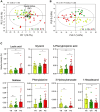Polystyrene Accelerates Aging Related-Gut Microbiome Dysbiosis and -Metabolites in Old-Aged Mouse
- PMID: 40774819
- PMCID: PMC12351109
- DOI: 10.4014/jmb.2504.04016
Polystyrene Accelerates Aging Related-Gut Microbiome Dysbiosis and -Metabolites in Old-Aged Mouse
Abstract
Microplastics, particularly polystyrene (PS), are ubiquitous environmental contaminants and concerns about their potential detrimental effects on human health are increasing. Emerging evidence suggests that microplastics may disrupt the gut microbiota, a critical ecosystem involved in regulating host metabolism, immunity, and aging processes. However, the specific effects of PS on the gut microbiota composition and its potential role in modulating aging are yet to be fully elucidated. In this study, we aimed to investigate the effects of PS exposure on gut microbiota dysbiosis and its potential role in the acceleration of aging. Gut microbiota composition was assessed using 16S rDNA sequencing, while fecal metabolites were analyzed using gas chromatography-mass spectrometry. Exposure to PS resulted in a significant reduction in the abundance of beneficial microbiota, including Blautia. In contrast, there was an increase in the relative abundance of potentially harmful taxa, such as Lachnospiraceae UCG-001, and Candidatus Arthromitus. Metabolomic analysis revealed elevated levels of several metabolites associated with stress responses and altered host metabolism, including alanine, serine, tryptophan, 5-aminovaleric acid, thymine, threonine, methionine, and benzoic acid. These findings demonstrate that PS exposure in aged mice exacerbated gut microbiome dysbiosis and altered key metabolic markers associated with aging, suggesting an increased vulnerability to age-related diseases as a consequence of microplastic exposure.
Keywords: 16S rDNA sequencing; Polystyrene; aging; gut microbiota; metabolite.
Conflict of interest statement
The authors have no financial conflicts of interest to declare.
Figures






Similar articles
-
Changes in the gut microbiota and derived fecal metabolites may play a role in tacrolimus-induced diabetes in mice.Future Microbiol. 2025 Feb;20(3):237-246. doi: 10.1080/17460913.2024.2444761. Epub 2024 Dec 22. Future Microbiol. 2025. PMID: 39711145
-
The impact of early-life exposures on growth and adult gut microbiome composition is dependent on genetic strain and parent- of- origin.Microbiome. 2025 Jun 16;13(1):143. doi: 10.1186/s40168-025-02130-w. Microbiome. 2025. PMID: 40524209 Free PMC article.
-
Aging Modulates the Effect of Dietary Glycemic Index on Gut Microbiota Composition in Mice.J Nutr. 2024 Sep;154(9):2852-2861. doi: 10.1016/j.tjnut.2024.07.014. Epub 2024 Jul 15. J Nutr. 2024. PMID: 39019160 Free PMC article.
-
Compositional and Metabolomic Shifts of the Gut Microbiome in Alcohol-Related Liver Disease.J Gastroenterol Hepatol. 2025 Sep;40(9):2176-2189. doi: 10.1111/jgh.17038. Epub 2025 Jun 24. J Gastroenterol Hepatol. 2025. PMID: 40556049 Free PMC article. Review.
-
Synbiotics, prebiotics and probiotics for solid organ transplant recipients.Cochrane Database Syst Rev. 2022 Sep 20;9(9):CD014804. doi: 10.1002/14651858.CD014804.pub2. Cochrane Database Syst Rev. 2022. PMID: 36126902 Free PMC article.
References
MeSH terms
Substances
LinkOut - more resources
Full Text Sources
Medical

